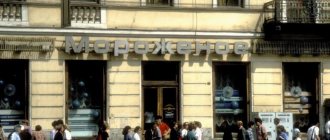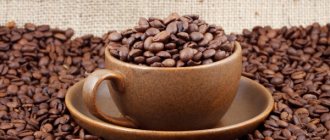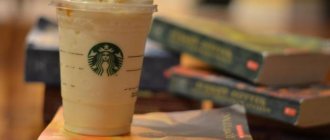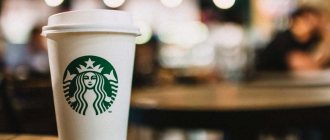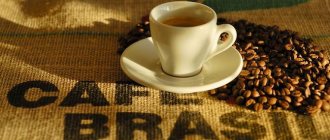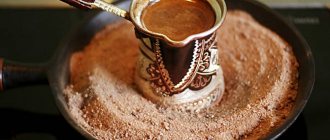Creation
Starbucks was founded in 1971 by three friends from Seattle:
- Jerry Baldwin, English teacher;
- Zev Seagle, history teacher;
- Gordon Bowker, writer.
They knew each other from their days at the University of San Francisco. The founders chipped in $1,350, borrowed another $5,000, and opened a store selling roasted coffee beans. For the first 9 months of operation, beans were purchased from Peet's Coffee, after which purchases began directly from farmers. The business was profitable, and soon Starbucks had its own roastery and a second outlet.
The enterprise turned into a chain of coffee shops with a different manager. By 1986, Starbucks had 6 of its own stores in Seattle, a small production facility, and an established mechanism for supplying coffee beans to bars, cafes, and restaurants. In 1987, former Starbucks marketing executive Howard Schultz bought the company from its founders and merged it with his own chain of coffee shops, Il Giornale. The combined enterprise began to develop under the name Starbucks. Already in 1992, the company had 165 retail outlets, at the same time it made an initial placement of its securities on the stock market.
By the end of 2021, the number of coffee shops around the world exceeded 24,000. A well-thought-out franchise scheme helped the company conquer the world.
“My friends, Gordon Bowker, Jerry Baldwin and I at that time often discussed and came up with interesting ideas for business, we all wanted to change our lives and do something big, meaningful and meaningful. We started meeting every few weeks to exchange ideas, and one day at lunch we ordered an espresso that turned out to be very bad,” Zev Siegl in an interview with The Guardian, 2021.
Jerry Baldwin, Gordon Bowker, Zev Seigl
The apotheosis of American romanticism
In 1970, there was neither a fashion for coffee nor a culture of drinking this drink in the United States. The idea of opening a wholesale store for quality coffee came to Gordon Bowker and seemed fresh and interesting to the whole company. Soon after this, the proud initiator went in search of a good product and quickly discovered it on the Canadian island of Vancouver with a real coffee docker - Alfred Peet, who agrees to play the role of mentor for the young people. The trio visited Pete's shop in San Francisco on several occasions, learning the art of roasting beans and running a business.
The first Starbucks coffee shop after “moving” to a new location is the 1912th pavilion of Pike Place Market. Photo vc.ru
According to the official legend, the name of the Starbucks company is nothing more than a tracing of the name of the character in the novel “Moby Dick” by Herman Melville, the first mate of Captain Ahava - Starbuck. At that time, Bowker and designer Terry Heckler were simultaneously working on creating their own advertising agency. After conducting a study, they suggested that names starting with the letter combination “ST” are remembered better than others.
It didn't take long to convince the other team members. Heckler, who later drew logos for several successful American brands, is also credited with creating the famous Starbucks logo - a seductive moray eel that was supposed to “lure” customers. And so it happened - throughout the history of the company, the logo was transformed three times, but its plot always remained unchanged, only the design of the two-tailed mermaid varied.
A few months later, after chipping in $1,500 and taking out a $5,000 loan from the bank, Siegle, Bowker and Baldwin rented space for a future store on Western Avenue, near Pike Place Market in Seattle. On March 30, 1971, the doors of the first Starbucks opened to customers. The store offered bulk purchases of roasted coffee beans, tea, spices, beans, and kitchenware. Coffee was brewed for tasting purposes only.
The fourth Starbucks store opens in Seattle. Photo: vc.ru
The work was in full swing: at first, Sigl was the only hired employee of the company, his partners continued to work at their main jobs, in order to maintain at least some kind of financial stability, all three of them went on shifts on weekends. The idea took off - the store began to be in demand, city cafes and restaurants began to cooperate with Starbucks, and sales were on the rise. In the first nine months, Starbucks' turnover exceeded $46 thousand, although all the proceeds went to pay rent, bills and the purchase of goods.
In the early years, the company purchased roasted beans from Peet's, and gradually the question of purchasing its own roasting machine began to arise. The kind mentor Alfred Peet also helped the young people with this. Starbucks rented a small warehouse in the fishing harbor area on the outskirts of Seattle and turned it into a modest roastery.
Starbucks logo
The coffee chain's name was borrowed from Herman Melville's novel Moby Dick. Captain Ahab's mate was named Starbuck. When creating the logo, a marine theme was also used. It depicts a siren - half-woman, half-fish, luring sailors with her beauty and mesmerizing singing.
The original image of a half-naked mermaid was taken from a 16th-century engraving. The designer did a little work on the character - they added a smile to him and removed his belly button. In 1987, green became the dominant color in the logo instead of brown. In 1992, the lower part of the siren's body was removed, and in 2011, nothing remained on the sign except a mythological creature in a green circle.
Red Bean Green Tea Frappuccino
Translation: Green Tea Red Bean Frappuccino Where sold: China and some Asian countries
Tea with beans sounds strange, of course. In Asian countries, adzuki (that's what beans are called in Chinese) is a common sweet. The beans are boiled with sugar, and sometimes sweet puree is made from it.
At Starbucks, sweetened red beans are placed on top of a Frappuccino whipped cream.
Starbucks drinks
The first Starbucks coffee shops offered several varieties of lattes and espressos . Howard Schultz brought many of the recipes from a trip to Italy, where he really liked the culture of coffee drinking. Following the hot ones, the assortment also included cold coffee drinks, including several types of Frappuccino. The main menu also includes about 10 types of tea - black, green, herbal, with and without caffeine. Specific recipes are distributed in certain regions, so a regular Starbucks customer in another country can often try something new.
In addition to drinks, the company sells its own baked goods and snacks, and continues to maintain its long-standing coffee bean business.
No one cares about Starbucks
In September of the same year, the company made a truly fateful decision: the position of Starbucks Marketing Director was taken by a native New Yorker, an experienced manager and salesman, and a passionate coffee lover, Howard Schultz.
“Tall, energetic, assertive and always dressed to the nines,” is how Baldwin and Bowker described the then 29-year-old specialist.
Six months later, Schultz is sent to an industry exhibition in Spain, and he returns from there already infected with a new idea: reformatting Starbucks into a chain of coffee shops.
The founders and owners of the company were adamant: Baldwin and Bowker believed that the wholesale sale of coffee beans would bring success and fame to the company rather than building a chain of coffee shops. However, Howard Schultz had plenty of stubbornness and perseverance: in 1984, Starbucks launched two more locations in Seattle and San Francisco - both espresso bar formats. In addition, the company had been preparing for the takeover of Peet's for a long time; in the fall of 1984, the deal was closed - Starbucks acquired another roasting shop and several outlets.
Two years later, having still not received approval for his “mega-idea” from management, Schultz left the company and started his own business - he founded Il Giornale, offering brewed coffee and espresso from Starbucks coffee beans. At this time, Gordon Bowker, being simultaneously employed in several large businesses at once, decides to sell his stake in Starbucks. Frightened by the weight of the burden that has fallen, Jerry Baldwin decides to put the company up for sale. For $3.8 million, Il Giornale, with a group of investors led by Howard Schultz, acquires the assets of Starbucks and changes its name to Starbucks Corporation.
Co-owner and ex-CEO of Starbucks Corporation Howard Schultz Photo Euronews
Starbucks corporate culture
Despite the fact that Howard Schultz was in charge of the overall management of the company, there were two other important people at its helm:
- Howard Behar, president of Starbucks International;
- Orin Smith, Chief Financial Officer.
The three heads worked so harmoniously that they were called H₂O by the first letters of their names - Howard, Howard and Orin.
Howard Behar wrote the book It's Not About the Coffee: The Corporate Culture of Starbucks, which is often listed on popular business literature lists. Its main idea is that a company needs to consider both employees and customers, first of all, as people. If this principle is followed, then everything else will come by itself.
White Peach Frappuccino
Translation: White Peach Frappuccino Where sold: Japan
The most unexpected thing is that, despite the name, there is no peach in this drink at all. Frappuccinos contain mango pulp, which is mixed with white mocha syrup, after which cream is added.
Surprisingly, the resulting mix tastes similar to white peach.
Starbucks franchise
The Starbucks empire is too big to be owned by one company. Today only 30% of establishments belong to the parent company, the rest operate as franchises. At the same time, management puts reputation first, which is why many applicants are rejected. Almost everything is controlled: the size of the room, its location and the location of the entrance doors, the interior, the menu and even the music playing in the hall.
Hidden Starbucks advertising from Apple
During the presentation of the first iPhone in 2007, Steve Jobs called Starbucks to demonstrate the capabilities of the new smartphone.
Jobs used Google Maps to find a coffee shop near him and dial its phone number on his iPhone. Having reached the phone, the Apple CEO, in an absolutely serious voice, ordered four thousand lattes to go, then apologized, explained to the operator that he was joking and had the wrong number, and then hung up to loud laughter from the audience.
It turned out to be a very funny hidden advertisement for one of the most famous coffee companies in the world.
Starbucks in Russia
Starbucks coffee shops came to our country quite late. The delay turned out to be due to a legal dispute - Starbucks LLC, which had nothing to do with the chain, appeared in the Russian Federation and registered the right to use this brand in Russia. As a result, the American corporation first had to fight for its own rights.
The first coffee shop in the Russian Federation was opened in September 2007 in the Mega-Khimki shopping center. Today there are about a hundred network points operating in the country, most of them are located in Moscow.
Company in 2017
Starbucks in 2021 is one of the most recognizable and valuable brands in the world. The value of the company's shares exceeds $60 per share, and the capitalization is $86.82 billion. Management plans to reach the value of Starbucks at $100 billion.
The Starbucks chain has approximately 24,000 retail locations and employs approximately 200,000 employees.
In the ranking of the most respected brands of 2021, Starbucks took 3rd place , behind two technology giants - Apple and Amazon. And in The FutureBrand Index 2016 the company took 36th position.
An important focus of Starbucks is protecting the environment. Every year it spends significant funds on projects to save energy and protect nature.
You can learn about Starbucks charity in numbers for 2021 from the video.
Collaborations
Starbucks regularly teams up with different brands to release joint products. In recent years, the coffee chain has made releases with women's clothing manufacturer Private Sun, TV presenter Oprah Winfrey and the famous notebook brand Moleskine (promo code for a 10% discount is STONE).
Company overview
The management of Starbucks coffee considers its goal not only to make money. The establishments create conditions that allow customers to feel comfortable.
Mission
Starbucks' initial goal was to transform the company into the world's leading coffee supplier, maintaining its principles as it evolves. Howard Schultz formulated a new mission. The brand now aims to “inspire and nourish the spirit—every person, with every cup of coffee, every day, everywhere.”
Management
The main ideological inspirer of the institution was Howard Schultz. In addition to him, management is now carried out by Howard Behar and Orin Smith. The management is distinguished by its attentive attitude towards each employee. Managers consider this approach to be the key to success, since a good working atmosphere motivates people to work better.
Corporate culture
According to Starbucks executives, they should treat both their employees and customers with respect. The rest will come on its own as a consequence. Howard Behar talks about this principle in detail in his book on the corporation.
Starbucks chips
Like any well-built commercial chain , Starbucks has several unique marketing techniques that ensure popularity.
- Product quality . All drinks on the menu are prepared using proprietary technologies from real high-quality raw materials and have their own shades of taste. For example, espresso will taste a little like tart caramel, and mocha will taste like nuts and vanilla. In addition, you can change the drink to your taste - for example, make it completely unsweetened, use soy milk, or add some special syrup.
. Coffee shops are located only on streets with high tourist or household traffic. Initially, they were placed exclusively on those routes where most people go to work and return home every day. Starbucks always stands where you want to rest.
Location- Interior . The design of the premises is different, but always looks calm, cozy and warm. Almost every table will have a different decoration, the music playing does not distract from conversations and work, the lighting is soft but quite intense. The room always smells like coffee. Even the windows and doors are located in a special way, only on the south or west side . This was done to prevent the bright sun from shining into the clients’ eyes.
- Communication . All employees communicate with the client during the coffee preparation process. Here it is considered quite normal to be friends with customers, and not just pretend. Single people have become much more comfortable visiting public places and not feeling uncomfortable.
Drinking coffee , tea or plain water is a matter of taste, but everyone should definitely Starbucks
American Butler company knows the best gastronomic spots in the USA , and will also tell you about the culture and life of America first hand. Read us on the website and on social networks , and if you have questions, suggestions or a desire to visit the states , welcome to the chat window.
"Name" glasses
The idea of writing on them the names of the people who ordered the drink and saying them loudly to the whole room turned out to be simple and ingenious. Such personalization and personal appeal to each of the visitors is very captivating and evokes special sympathy for the brand. This idea became the one that makes Starbucks stand out from all other coffee shops.
The barista must communicate openly and kindly with all customers. This is almost officially recorded as his main job responsibility. If a barista is a top performer but is naturally uncommunicative, he won't be hired at Starbucks.
When coffee shops purchased new bulky coffee machines in the 2000s, and they began to block the baristas from customers, the decision was immediately made to redesign the bar counter so that the employee and customers had open visual contact. Otherwise, such isolation contradicted the main idea of Starbucks - “communication and more communication!”
Bright room
In every Starbucks coffee shop, doors and windows always face east or south. If the front side of the premises faces north, Starbucks will never rent it, even if it is in the most prime location in the city. This is another fundamental principle of the establishment, from which they never deviate.
“This requirement for the premises is based on the fact that it is much more pleasant for visitors to be in a well-lit place with penetrating daylight, but at the same time the light should not dazzle the eyes,” say the company’s managers.
Tricky Marketing
Although one gets the impression of Starbucks as a company that does everything not for profit, but for the comfort of people, some advertising gimmicks and competitive advantages are still being developed. And I must say, very successfully. For example, using corrugated cardboard rings for paper cups to keep your hands cool. These rings are free, but if you pay a little extra, you can get a polyurethane product with a beautiful Starbucks logo. The idea of the second type of ring is both the opportunity to earn additional profit and the fact that the client can carry such a ring with him and use it on subsequent coffee purchases.
Thermal cups, sold on the caffeine chain for a long time, are also a definite marketing ploy. In the future, the client will use them for other drinks in his daily life. At the same time, the Starbucks logo will always appear on the glass, providing the brand with additional advertising.
Musical accompaniment
It is also carefully thought out. When you enter a coffee shop, you will hear pleasant, unobtrusive music. At that moment, the same song will be played in all the coffee shops of the chain. You can even buy a CD with the music playing at Starbucks and listen to it at home. This is a kind of music network that covers absolutely all Starbucks locations around the world. Visitors love it, and those who are not yet aware of this fact become even more fond of the brand.
For example, you are sitting in New York over a cup of coffee and listening to a song, and at the same time your friend from Seattle is also relaxing at a local Starbucks, and they are playing the same music as you - isn’t it touching?
Competitors
The company has no competitors in the global market. We have to compete only with regional companies. The main German competitor is Tchibo. In the UK, you have to fight for customers with Costa Coffee, and in France - with Nespresso.
